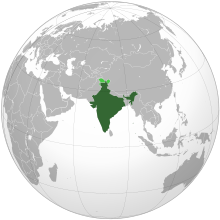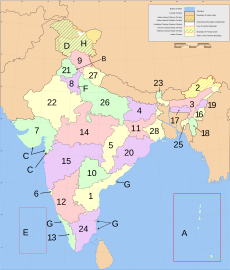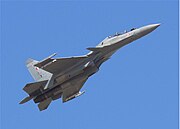India, officially the Republic of India (Hindi: भारत गणराज्य Bhārat Gaṇarājya; see also other Indian languages), is a country in South Asia. It is the seventh-largest country by geographical area, the second-most populous country, and the most populous democracyin the world. Bounded by the Indian Ocean on the south, the Arabian Sea on the west, and the Bay of Bengal on the east, India has a coastline of 7,517 kilometres (4,700 mi).[14] It is bordered by Pakistan to the west;[15] People's Republic of China (PRC), Nepal, and Bhutanto the north; and Bangladesh and Myanmar to the east. India is in the vicinity of Sri Lanka, the Maldives, and Indonesia in the Indian Ocean.
Home to the Indus Valley Civilisation and a region of historic trade routes and vast empires, the Indian subcontinent was identified with its commercial and cultural wealth for much of its long history.[16] Four major religions, Hinduism, Buddhism, Jainism and Sikhismoriginated there, while Zoroastrianism, Judaism, Christianity and Islam arrived in the first millennium CE and shaped the region's diverse culture. Gradually annexed by the British East India Company from the early eighteenth century and colonised by the United Kingdom from the mid-nineteenth century, India became an independent nation in 1947 after a struggle for independence that was marked by widespread nonviolent resistance.[17]
India is a republic consisting of 28 states and seven union territories with a parliamentary system of democracy. It has the world's twelfth largest economy at market exchange ratesand the fourth largest in purchasing power. Economic reforms since 1991 have transformed it into one of the fastest growing economies;[18] however, it still suffers from high levels ofpoverty,[19] illiteracy, disease, and malnutrition. A pluralistic, multilingual, and multiethnic society, India is also home to a diversity of wildlife in a variety of protected habitats.
Contents[hide] |
Etymology
The name India (pronounced /ˈɪndiə/) is derived from Indus, which is derived from the Old Persian word Hindu, from Sanskrit Sindhu, the historic local appellation for the Indus River.[20] The ancient Greeks referred to the Indians as Indoi (Ινδοί), the people of the Indus.[21] The Constitution of India and common usage in various Indian languages also recognise Bharat (pronounced [bʱaːrət] (![]() listen)) as an official name of equal status.[22]The name Bharat is derived from the name of the legendary king Bharata in Hindu Mythology. Hindustan (
listen)) as an official name of equal status.[22]The name Bharat is derived from the name of the legendary king Bharata in Hindu Mythology. Hindustan (![]() /hin̪d̪ust̪ɑːn/ ), which is the Persian word for “Land of the Hindus” and historically referred to northern India, is also occasionally used as a synonym for all of India.[23]
/hin̪d̪ust̪ɑːn/ ), which is the Persian word for “Land of the Hindus” and historically referred to northern India, is also occasionally used as a synonym for all of India.[23]
History
Stone Age rock shelters with paintings at the Bhimbetka rock shelters in Madhya Pradeshare the earliest known traces of human life in India. The first known permanent settlements appeared over 9,000 years ago and gradually developed into the Indus Valley Civilisation,[24]dating back to 3300 BCE in western India. It was followed by the Vedic period, which laid the foundations of Hinduism and other cultural aspects of early Indian society, and ended in the 500s BCE. From around 550 BCE, many independent kingdoms and republics known as the Mahajanapadas were established across the country.[25]
In the third century BCE, most of South Asia was united into the Maurya Empire by Chandragupta Maurya and flourished under Ashoka the Great.[26]From the third century CE, the Gupta dynasty oversaw the period referred to as ancient "India's Golden Age."[27][28] Empires in Southern India included those of the Chalukyas, the Cholas and the Vijayanagara Empire. Science, technology, engineering, art, logic,language, literature, mathematics, astronomy, religionand philosophy flourished under the patronage of these kings.
Following invasions from Central Asia between the 10th and 12th centuries, much of North India came under the rule of the Delhi Sultanate and later the Mughal Empire. Under the rule of Akbar the Great, India enjoyed much cultural and economic progress as well as religious harmony.[29][30] Mughal emperors gradually expanded their empires to cover large parts of the subcontinent. However, in North-Eastern India, the dominant power was the Ahom kingdom ofAssam, among the few kingdoms to have resisted Mughal subjugation. The first major threat to Mughal imperial power came from a HinduRajput king Maha Rana Pratap of Mewar in the 14th century and later from a Hindu state known as the Maratha confederacy, that dominated much of India in the mid-18th century.[31]
From the 16th century, European powers such as Portugal, the Netherlands, France, and the United Kingdom established trading posts and later took advantage of internal conflicts to establish colonies in the country. By 1856, most of India was under the control of the British East India Company.[32] A year later, a nationwide insurrection of rebelling military units and kingdoms, known as India's First War of Independenceor the Sepoy Mutiny, seriously challenged the Company's control but eventually failed. As a result of the instability, India was brought under the direct rule of the British Crown.
In the 20th century, a nationwide struggle for independence was launched by the Indian National Congressand other political organisations. Indian leader Mahatma Gandhi led millions of people in national campaigns of non-violent civil disobedience.[17] On 15 August 1947, India gained independence from British rule, but at the same time Muslim-majority areas were partitioned to form a separate state of Pakistan.[33]On 26 January 1950, India became a republic and a new constitution came into effect.[34]
Since independence, India has faced challenges from religious violence, casteism, naxalism, terrorism and regional separatist insurgencies, especially in Jammu and Kashmir and Northeast India. Since the 1990sterrorist attacks have affected many Indian cities. India has unresolved territorial disputes with P. R. China, which in 1962 escalated into the Sino-Indian War; and with Pakistan, which resulted in wars in 1947, 1965,1971 and 1999. India is a founding member of the United Nations (as British India) and the Non-Aligned Movement. In 1974, India conducted an underground nuclear test[35] and five more tests in 1998, making India a nuclear state.[35] Beginning in 1991, significant economic reforms[36] have transformed India into one of the fastest-growing economies in the world, increasing its global clout.[18]
Government
| Flag | Tricolour |
| Emblem | Sarnath Lion Capital |
| Anthem | Jana Gana Mana |
| Song | Vande Mataram |
| Animal | Royal Bengal Tiger |
| Bird | Indian Peafowl |
| Flower | Lotus |
| Tree | Banyan |
| Fruit | Mango |
| Sport | Field hockey |
| Calendar | Saka |
The Constitution of India, the longest and the most exhaustive constitution of any independent nation in the world, came into force on 26 January, 1950.[38] The preamble of the constitution defines India as asovereign, socialist, secular, democratic republic.[39] India has a bicameral parliament operating under aWestminster-style parliamentary system. Its form of government was traditionally described as being 'quasi-federal' with a strong centre and weaker states,[40] but it has grown increasingly federal since the late 1990s as a result of political, economic and social changes.[41]
The President of India is the head of state[42] elected indirectly by an electoral college[43] for a five-year term.[44][45] The Prime Minister is the head of government and exercises most executive powers.[42]Appointed by the President,[46] the Prime Minister is by convention supported by the party or political alliance holding the majority of seats in the lower house of Parliament.[42] The executive branch consists of the President, Vice-President, and the Council of Ministers (the Cabinet being its executive committee) headed by the Prime Minister. Any minister holding a portfolio must be a member of either house of parliament. In the Indian parliamentary system, the executive is subordinate to the legislature, with the Prime Minister and his Council being directly responsible to the lower house of the Parliament.[47]
The Legislature of India is the bicameral Parliament, which consists of the upper house called the Rajya Sabha (Council of States) and the lower house called the Lok Sabha (House of People).[48] The Rajya Sabha, a permanent body, has 245 members serving staggered six year terms.[49] Most are elected indirectly by the state and territorial legislatures in proportion to the state's population.[49] 543 of the Lok Sabha's 545 members are directly elected by popular vote to represent individual constituencies for five year terms.[49] The other two members are nominated by the President from the Anglo-Indian community if the President is of the opinion that the community is not adequately represented.[49]
India has a unitary three-tier judiciary, consisting of the Supreme Court, headed by the Chief Justice of India, twenty-one High Courts, and a large number of trial courts.[50] The Supreme Court has original jurisdiction over cases involving fundamental rights and over disputes between states and the Centre, and appellate jurisdiction over the High Courts.[51] It is judicially independent,[50] and has the power to declare the law and to strike down Union or State laws which contravene the Constitution.[52] The role as the ultimate interpreter of the Constitution is one of the most important functions of the Supreme Court.[53]
Administrative divisions
India consists of twenty-eight states and seven Union Territories.[54] All states, and the two union territories of Puducherry and the National Capital Territory of Delhi, have elected legislatures and governments patterned on the Westminster model. The other five union territories are directly ruled by the Centre through appointed administrators. In 1956, under the States Reorganisation Act, states were formed on a linguistic basis.[55] Since then, this structure has remained largely unchanged. Each state or union territory is further divided into administrativedistricts.[56] The districts in turn are further divided into tehsils and eventually into villages.
States:
Union Territories:
Politics
India is the most populous democracy in the world.[57][58] For most of the years since independence, the federal government has been led by the Indian National Congress (INC).[54] Politics in the states have been dominated by several national parties including the INC, the Bharatiya Janata Party (BJP), the Communist Party of India (Marxist) (CPI(M)) and various regional parties. From 1950 to 1990, barring two brief periods, the INC enjoyed a parliamentary majority. The INC was out of power between 1977 and 1980, when theJanata Party won the election owing to public discontent with the state of emergency declared by the then Prime Minister Indira Gandhi. In 1989, a Janata Dal-led National Front coalition in alliance with the Left Front coalition won the elections but managed to stay in power for only two years.[59] As the 1991 elections gave no political party a majority, the INC formed a minority government under Prime Minister P.V. Narasimha Rao and was able to complete its five-year term.[60]
The years 1996–1998 were a period of turmoil in the federal government with several short-lived alliances holding sway. The BJP formed a government briefly in 1996, followed by the United Front coalition that excluded both the BJP and the INC. In 1998, the BJP formed the National Democratic Alliance (NDA) with several other parties and became the first non-Congress government to complete a full five-year term.[61] In the2004 Indian elections, the INC won the largest number of Lok Sabha seats and formed a government with a coalition called the United Progressive Alliance (UPA), supported by various Left-leaning parties and members opposed to the BJP. The UPA again came into power in the2009 general election; however, the representation of the Left leaning parties within the coalition has significantly reduced.[62] Manmohan Singhbecame the first prime minister since Jawaharlal Nehru in 1962 to be re-elected after completing a full five-year term.[63]
Foreign relations and military
Since its independence in 1947, India has maintained cordial relationships with most nations. It took a leading role in the 1950s by advocating the independence of European colonies in Africa and Asia.[65] India was involved in two brief military interventions in neighbouring countries – Indian Peace Keeping Force in Sri Lanka and Operation Cactus in Maldives. India is a member of the Commonwealth of Nations and a founding member of the Non-Aligned Movement.[66] After the Sino-Indian War and the Indo-Pakistani War of 1965, India's relationship with the Soviet Union warmed and continued to remain so until the end of the Cold War. India has fought two wars with Pakistan over the Kashmir dispute. A third war between India and Pakistan in 1971 resulted in the creation of Bangladesh (then East Pakistan).[67] Additional skirmishes have taken place between the two nations over the Siachen Glacier. In 1999, India and Pakistan fought anundeclared war over Kargil.
In recent years, India has played an influential role in the SAARC, and the WTO.[69] India has provided as many as 55,000 Indian military and police personnel to serve in thirty-five UN peace keeping operations across four continents.[70] Despite criticism and military sanctions, India has consistently refused to sign the CTBT and the NPT, preferring instead to maintain sovereignty over its nuclear program. Recent overtures by the Indian government have strengthened relations with the United States, China and Pakistan. In the economic sphere, India has close relationships with other developing nations in South America, Asia and Africa.
India maintains the third-largest military force in the world, which consists of the Indian Army, Navy, Air Force[34] and auxiliary forces such as the Paramilitary Forces, the Coast Guard, and the Strategic Forces Command. The President of India is the supreme commander of the Indian Armed Forces. India maintains close defence cooperation with Russia, Israel and France, who are the chief suppliers of arms. The Defence Research and Development Organisation (DRDO) oversees indigenous development of sophisticated arms and military equipment, including ballistic missiles, fighter aircraft and main battle tanks, to reduce India's dependence on foreign imports. India became a nuclear power in 1974 after conducting an initial nuclear test, Operation Smiling Buddha andfurther underground testing in 1998. India maintains a "no first use" nuclear policy.[71] On 10 October, 2008 Indo-US civilian nuclear agreementwas signed, prior to which India received IAEA and NSG waivers, ending restrictions on nuclear technology commerce with which India became de facto sixth nuclear power in world.[72]
Geography
India, the major portion of the Indian subcontinent, sits atop the Indian tectonic plate, a minor plate within the Indo-Australian Plate.[73]
India's defining geological processes commenced seventy-five million years ago, when the Indian subcontinent, then part of the southern supercontinent Gondwana, began a northeastwards drift—lasting fifty million years—across the then unformed Indian Ocean.[73] The subcontinent's subsequent collision with the Eurasian Plate and subduction under it, gave rise to the Himalayas, the planet's highest mountains, which now cover India in the north and the north-east.[73] In the former seabed immediately south of the emerging Himalayas, plate movement created a vast trough, which, having gradually been filled with river-borne sediment,[74] now forms the Indo-Gangetic Plain.[75] To the west of this plain, and cut off from it by the Aravalli Range, lies the Thar Desert.[76] The original Indian plate now survives as peninsular India, the oldest and geologically most stable part of India, and extending as far north as the Satpura and Vindhyaranges in central India. These parallel ranges run from the Arabian Sea coast in Gujarat in the west to thecoal-rich Chota Nagpur Plateau in Jharkhand in the east.[77] To their south, the remaining peninsular landmass, the Deccan Plateau, is flanked on the left and right by the coastal ranges, Western Ghats and Eastern Ghats respectively;[78] the plateau contains the oldest rock formations in India, some over one billion years old. Constituted in such fashion, India lies to the north of the equator between 6°44' and 35°30' north latitude[79] and 68°7' and 97°25' east longitude.[80]
India's coast is 7,517 kilometres (4,700 mi) long; of this distance, 5,423 kilometres (3,400 mi) belong to peninsular India, and 2,094 kilometres (1,300 mi) to the Andaman, Nicobar, and Lakshadweep Islands.[14] According to the Indian naval hydrographic charts, the mainland coast consists of the following: 43% sandy beaches, 11% rocky coast including cliffs, and 46% mudflats or marshy coast.[14]
Major Himalayan-origin rivers that substantially flow through India include the Ganges and the Brahmaputra, both of which drain into the Bay of Bengal.[81] Important tributaries of the Ganges include the Yamuna and the Kosi, whose extremely low gradient causes disastrous floods every year. Major peninsular rivers whose steeper gradients prevent their waters from flooding include the Godavari, the Mahanadi, the Kaveri, and theKrishna, which also drain into the Bay of Bengal;[82] and the Narmada and the Tapti, which drain into theArabian Sea.[83] Among notable coastal features of India are the marshy Rann of Kutch in western India, and the alluvial Sundarbans delta, which India shares with Bangladesh.[84] India has two archipelagos: theLakshadweep, coral atolls off India's south-western coast; and the Andaman and Nicobar Islands, a volcanic chain in the Andaman Sea.[85]
India's climate is strongly influenced by the Himalayas and the Thar Desert, both of which drive themonsoons.[86] The Himalayas prevent cold Central Asian katabatic winds from blowing in, keeping the bulk of the Indian subcontinent warmer than most locations at similar latitudes.[87][88] The Thar Desert plays a crucial role in attracting the moisture-laden southwest summer monsoon winds that, between June and October, provide the majority of India's rainfall.[86] Four major climatic groupings predominate in India: tropical wet, tropical dry, subtropical humid, and montane.[89]















0 comments:
Post a Comment